Friday Mar. 7, 2008
There are still a few more sets of Expt. #3 materials available for
checkout.
The Experiment #4 materials should become
available next week.
Note: By the end
of next
week you should either already have completed an experiment, should be
working on an experiment, or should be working on one of the other
options (book report, scientific
paper report).
Before we
start to look at radiant energy balance on the earth we
need to learn about filters. The atmosphere will filter sunlight
as it
passes through the atmosphere toward the ground. The atmosphere
will
also filter IR radiation emitted by the earth as it trys to travel into
space.
We will first look at the effects simple blue, green, and red glass
filters have on visible light. This figure wasn't shown in class.

If you try to shine white light (a mixture of all the colors) through a
blue filter, only the blue light passes through. The filter
absorption curve shows 100% absorption at all but a narrow range of
wavelengths that correspond to blue light. Similarly the green
and red filters only let through green and red light.
The following figure is a simplified easier to remember
representation of the
filtering effect of
the atmosphere on UV, VIS, and IR light (found on p. 69 in the
photocopied notes). The
figure below was redrawn after class for improved clarity.
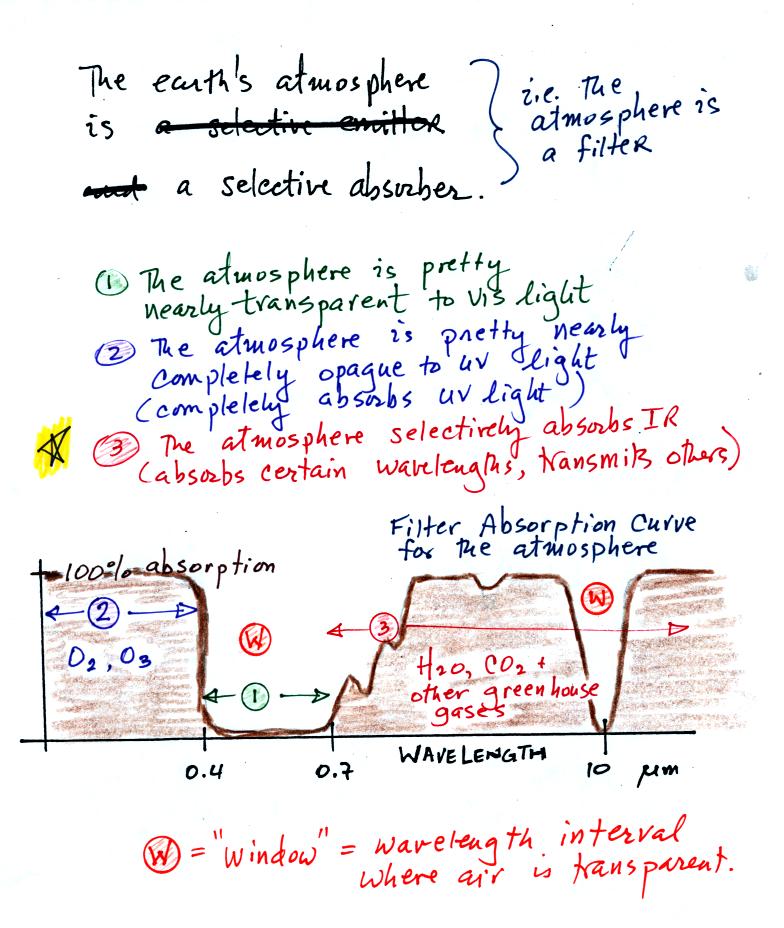
You can use your own eyes to tell you what the filtering effect of the
atmosphere is on visible light. Air is clear, it is
transparent. The atmosphere transmits visible light.
In our simplified representation oxygen and ozone make the atmosphere a
pretty good absorber of UV light.
Greenhouse gases make the
atmosphere a
selective absorber of IR light - it absorbs certain IR wavelengths and
transmits others. It is the atmosphere's ability to absorb (and
also emit) certain wavelengths of infrared light that produces the
greenhouse effect and warms the surface of the earth.
Note "The atmospheric window"
centered at 10 micrometers. Light emitted by the earth at this
wavelength will pass through the atmosphere. Another transparent
region, another window, is found in the visible part of the spectrum.
You'll find a more realistic picture of the atmospheric absorption
curve on p. 70 in the photocopied Classnotes, but the simplified
version above will work fine for our needs.
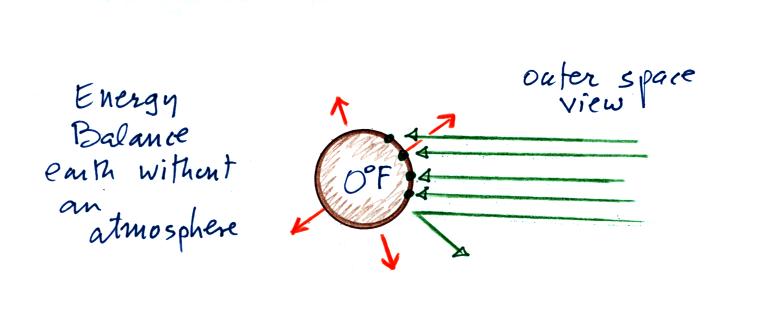
We will be moving from an outer space vantage point of radiative
equilibrium (above) to the earth's
surface (below).
Don't let the fact that there are
4 arrows are being absorbed and
emitted in the top figure
and only 2 arrows absorbed and emitted in the bottom figure
bother you
We'll be adding a lot more arrows to the bottom figure
It would get to complicated if we had more than 2 arrows of incoming
sunlight.
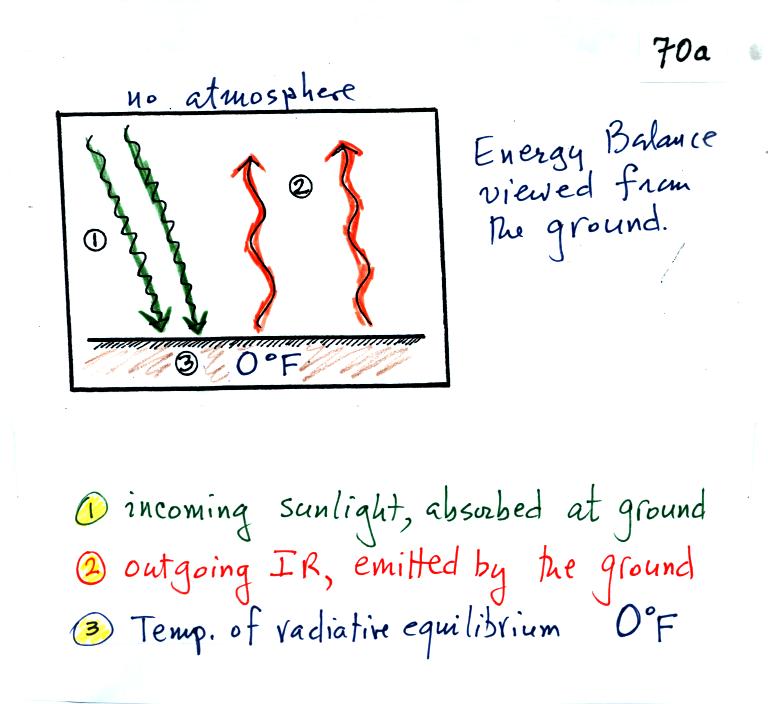
The next
step is to add the atmosphere.
We will study a simplified version of radiative equilibrium just so you
can identify and understand the various parts of the picture.
Keep an eye out for the greenhouse effect. We will look at a more
realistic version later.
Here's the figure that we ended up with in class
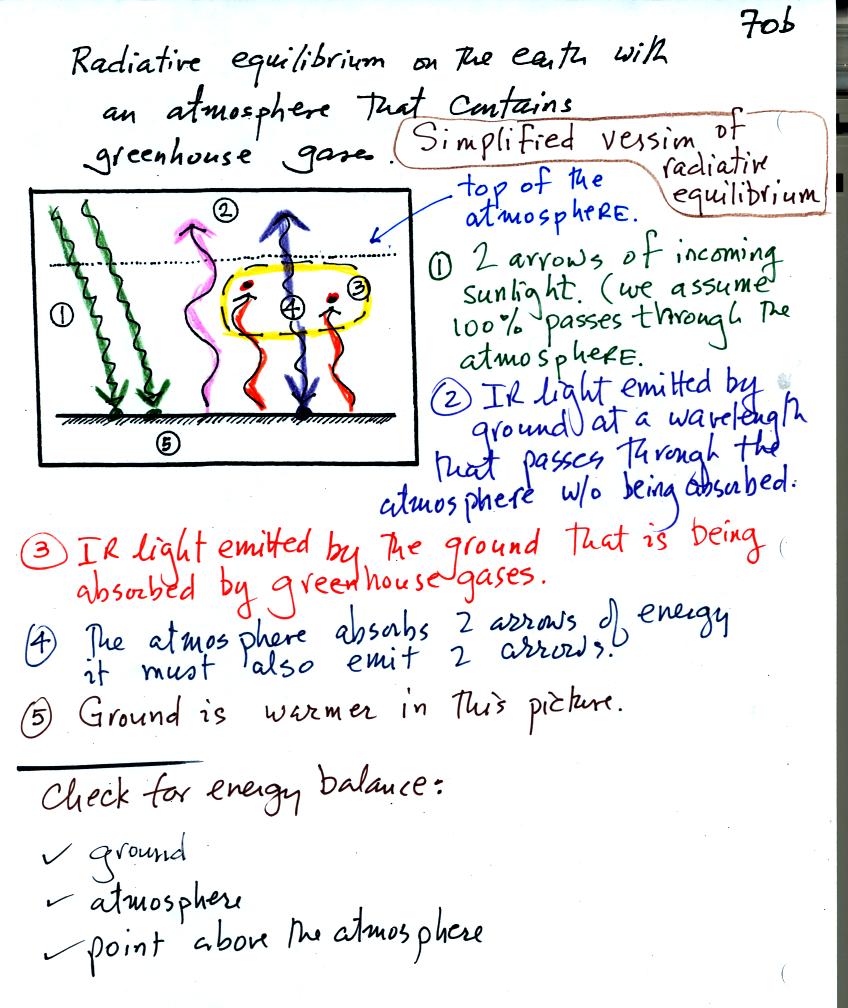
It would be hard to sort through all of this if you weren't in class
(and maybe even if you were) to see how it developed. So below we
will go through it again step by step (which you are free to skip over
if you wish).
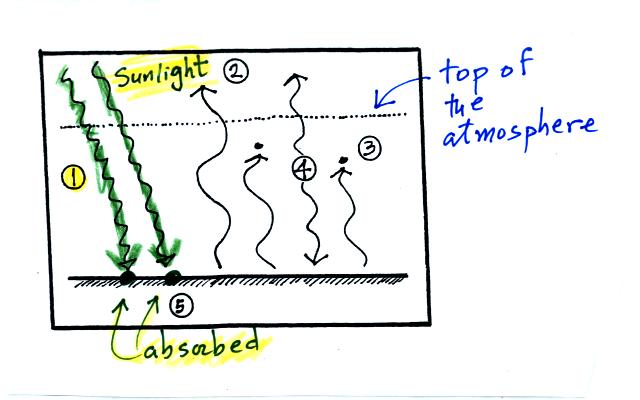
The figure shows two rays of incoming sunlight that
pass through the atmosphere, reach the ground, and are absorbed.
100% of the incoming sunlight is transmitted by the atmosphere (this is
not a very realistic assumption).
The ground is emitting 3 rays of IR radiation.
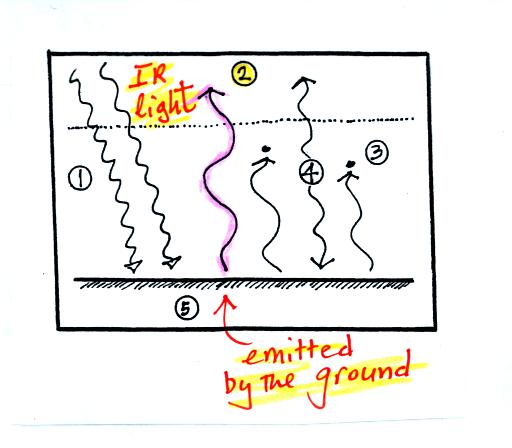
One of these is emitted by the ground at a wavelength that is
NOT absorbed by greenhouse gases in the atmosphere. This
radiation passes through the atmosphere and goes out into space.

The other 2 units of IR radiation emitted by the ground are
absorbed by
greenhouse gases is the atmosphere.

The atmosphere is absorbing
2 units of radiation.
In order to be in radiative equilibrium,the atmosphere must also emit 2
units of radiation. 1
unit of IR radiation is sent upward into space, 1 unit is sent downward
to the ground where it is absorbed.

The greenhouse effect is found in this absorption and emission
of IR radiation by the atmosphere. We tried to put into words
what is illustrated above:
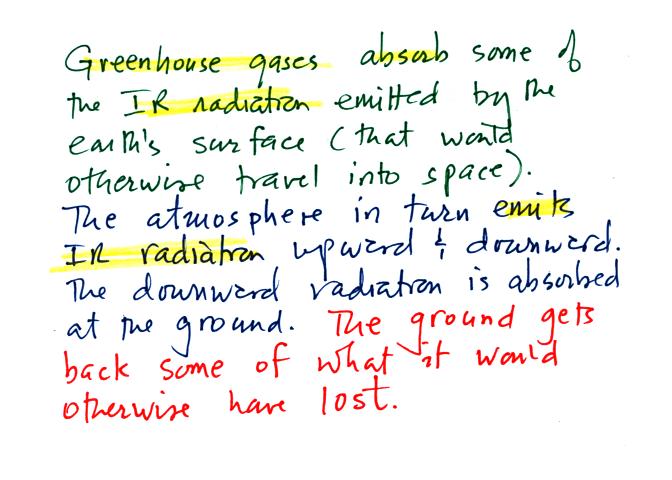
Before we go any further we will check to be sure that
every part
of this picture is in energy balance.
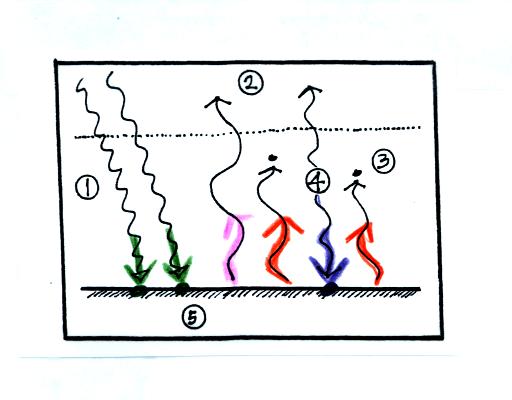
The ground is absorbing 3 units of energy and emitting
3
units of energy

The atmosphere is absorbing 2 units of energy and emitting 2
units of
energy
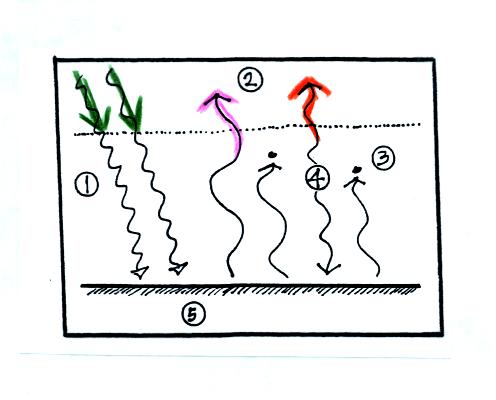
2 units of energy arrive at the earth from outer space, 2 units
of
energy leave the earth and head back out into space.
The
greenhouse effect makes the earth's surface warmer than it would be
otherwise.
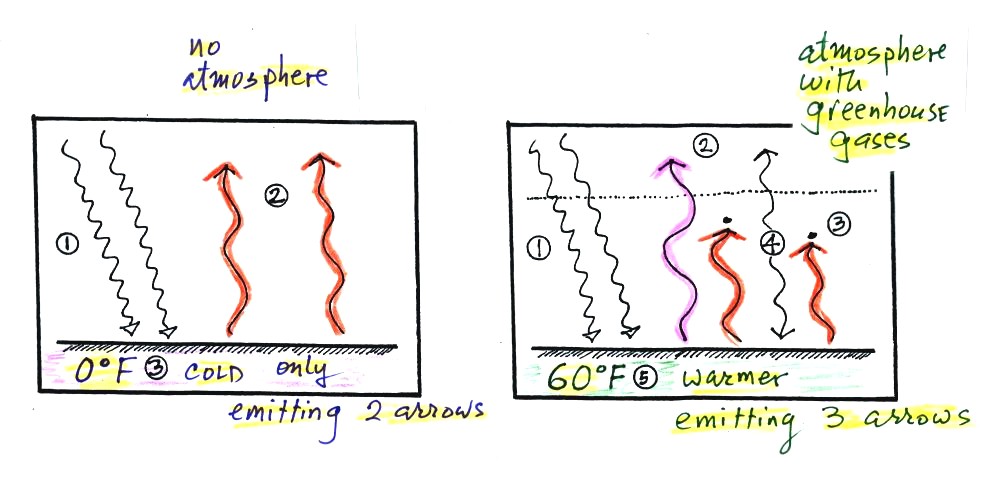
Energy balance with (right) and without (left) the
greenhouse
effect. At left the ground is emitting 2 units of energy, at
right the ground is emitting 3 units. Remember that the amount of
energy emitted by something depends on temperature. Warm ground
will emit more energy than colder ground.
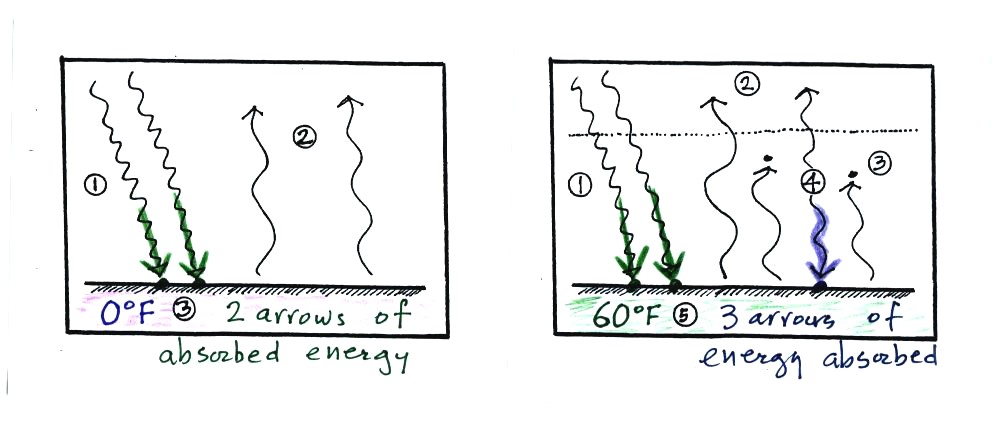
Here's another explanation. At left the ground
is getting 2 units of energy. At right it is getting three, the
extra one is coming from the atmosphere. Doesn't it make sense
that ground that absorbs 3 units of energy will be warmer than ground
that is only absorbing 2.
Next
we will look at how realistic our simplifying assumptions are

In our simplified version of the greenhouse
effect we
assumed that
100%
of the sunlight arriving at the top of the atmosphere passes through
the atmosphere and gets absorbed by the ground. The bottom figure
above shows that in reality only about 50% of the incoming sunlight
gets absorbed at the ground.
About 20% of the incoming sunlight is absorbed by gases in the
atmosphere. Sunlight is a
mixture of UV, VIS, and IR light.
Ozone and oxygen will absorb a lot of the UV (though there isn't much
UV in sunlight) and greenhouse gases will absorb some of the IR
radiation in sunlight (IR light accounts for about half of the light in
sunlight).
The remaining 30% of the incoming sunlight is reflected back into space
(by the ground, clouds, even air molecules).
Students
working on Experiment #3 will be measuring the energy in the sunlight
that actually arrives at the ground. We watched a couple of short
video tapes showing Experiment #3. The 2nd, and by far the better
of the two tapes, was put together several years ago by a student
enrolled in NATS 101.
You can find some additional discussion of Experiment #3 here.
Next we
will look at our simplified version of radiative equilibrium and a more
realistic picture of the earth's energy budget.

The lower part of the figure is pretty complicated. It
would be
difficult to start with this figure and find the greenhouse effect in
it. However if you understand the upper figure, you should be
able to find and understand the corresponding part in the lower figure.
In the top figure you should recognize the incoming sunlight (green),
IR emitted by the ground that passes through the atmosphere (pink), IR
radiation emitted by the ground that is absorbed by greenhouse gases in
the atmosphere (orange) and IR radiation emitted by the atmosphere
(dark blue). Using the colors you can find each of these parts of
the energy budget in the bottom figure. Notice that conduction,
convection, and latent heat energy transport are needed to bring the
overall energy budget into balance. Click here to see a more detailed
check to be sure everything is in energy balance.

















